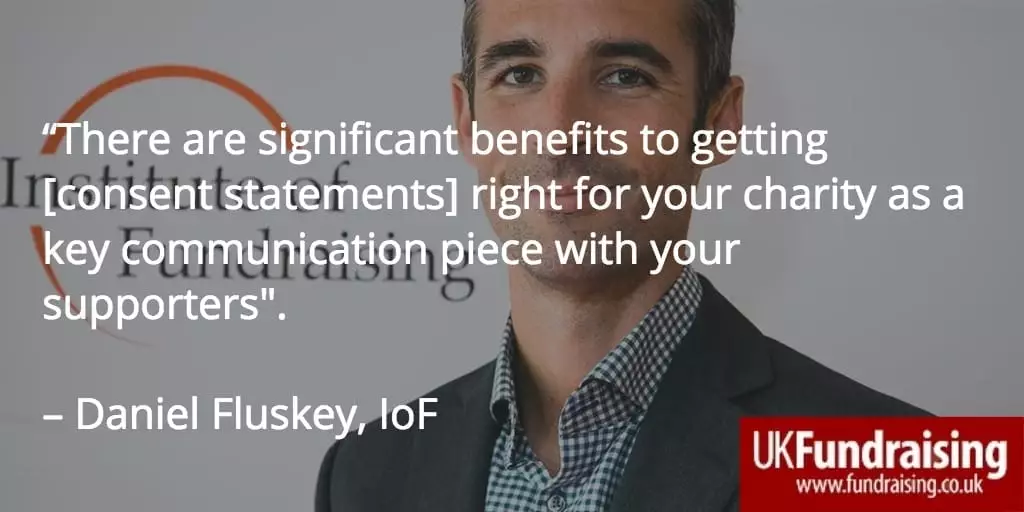How to create charity permission statements: new guide published
Can you be sure that you are seeking the right kind of permission from donors to communicate with them legally and ethically? It is becoming ever more important for fundraisers to ensure that they are.
A new guide from marketing insight specialists fast.MAP, published this month, aims to help fundraisers achieve this. Written by fast.MAP’s MD David Cole, the guide emphasises that each charity will probably need its own tailored permission statement: cut and paste from similar organisations’ statements is simply not sufficient.
Consent is a marketing as well as a legal issue
The guide is not intended as a simple statement of current legislation. Indeed, the author points out that he is not a lawyer. Instead, he explicitly argues that “consent should be seen as a marketing issue, as well as a legal one”.
The Institute of Fundraising’s Head of Policy and Research, Daniel Fluskey, who contributes the foreword to the guide, supports this approach, saying:
“Of course, you have to comply with the law, but consent statements are about communicating with your donors, the wording you use and the way you use it makes a difference”.
Advertisement
He welcomed its publication as “particularly timely” given that “how charities use an individual’s personal data for marketing purposes has been at the centre of current and on-going debate about ethical fundraising practice”.
Cole acknowledges from the outset that “being able to talk to your supporters is a privilege, not a right”. His guide provides a structured approach to writing consent statements and features tips about what does and does not work. Throughout it makes it clear that consent statements need to change to remain fresh and relevant.
Different language for different audiences
Cole argues that the days of a single consent statement for all audiences and marketing channels are now gone. He argues that consent marketing needs a segmented approach “for the same reasons that a charity would never create a mailing pack for use in all circumstances to all prospects”.
He lists 15 attributes which affect consent, ranging from ‘rewarding’, ‘appreciated’, through ‘I’m in charge’ and ‘No over contact’ to ‘trustworthy’ and ‘jargon free’. It is understanding which attributes to apply to which type of supporter that Cole believes will help charities maximise consent.
Increasing consent
The guide looks at ways to increase (or decrease) consent to a particular marketing channel, simply by changing the structure and phrasing of the statement.
Often, consent statements acknowledge the negative e.g. “we won’t misuse your data” or “we won’t send you too many messages”. What would a consent statement that is reassuring, relevant and motivating to a donor look like?
Clarity of consent is not always present in some charities’ consent statements. Sometimes supporters will have “legally consented” but will not have intended to consent. Charities will need to pay particular attention to this issue, given the expected trend towards consent which is “freely given, specific and unambiguous”. Many charities use opt-out but opt-in seems to be the direction of travel: how will charities manage the transition and resulting data shrinkage if and when they make that transition?
Testing and optimising statements
Cole explains how to testing consent statements, starting with benchmarking research and then proceeding to live testing. He encourages charities to expect to see some initial improvements in consent levels, if only because most current consent statements were developed years ago by a lawyer.
Fundraisers won’t be surprised that Cole suggests that consent statements are a work in progress: they should be tested and optimised on an ongoing basis.
“Charities can no longer afford to take consent for granted. They must track levels and be poised to review and update permission statements as times and attitudes change”.
Barnardo’s on the guide
Siobhan Handley, Senior Direct Marketing Manager, Barnardo’s, said:
“
Making consent a central part of Barnardo’s marketing communications process is a complex and lengthy process. We found that more appropriate than a “scatter gun” live testing approach was a meticulous and phased benchmarked research process allowing us to iteratively improve and predict performance at different segment levels as well as allowing us to understand why that performance was achieved. A process away from our supporters means that there are no technical legal issues to deal with whilst learning. The ability to compare performance of our statements with other brands is both reassuring and enlightening.
“This useful guide lays out some of the important principles charities should adopt when embarking on the lengthy and organisation wide challenge of making consent a marketing process.”
RNLI on the guide
Jayne Clarke, Head of Marketing Services & Support at RNLI, welcomed the guide, saying:
“The RNLI has decided to move to opt-in communications by 2017 – before legislation comes in. This is because it’s the right thing to do for us and our supporters, and we’re in a position to be able to take these steps. This doesn’t mean it’s not a daunting prospect; we estimate we could lose £35.6 million over the next five years, so the pressure is on to make opt in work.
“Any guidance on how to get the best out of an opt-in system is welcome, and we’re also happy to share what we learn with other charities who may be interested.”
Download the guide
David Cole is Research Champion to the Institute of Fundraising Insight Special Interest Group, and he is offering the 15-page guide to Institute members for free. The standard charge is £50.
In addition, he is also offering the guide for free to UK Fundraising’s readers. Download A Guide to Creating Charity Permission Statements from fast.MAP.
Main image: People tickbox consent – by Jakub Grygier on Shutterstock.com





 Making consent a central part of Barnardo’s marketing communications process is a complex and lengthy process. We found that more appropriate than a “scatter gun” live testing approach was a meticulous and phased benchmarked research process allowing us to iteratively improve and predict performance at different segment levels as well as allowing us to understand why that performance was achieved. A process away from our supporters means that there are no technical legal issues to deal with whilst learning. The ability to compare performance of our statements with other brands is both reassuring and enlightening.
Making consent a central part of Barnardo’s marketing communications process is a complex and lengthy process. We found that more appropriate than a “scatter gun” live testing approach was a meticulous and phased benchmarked research process allowing us to iteratively improve and predict performance at different segment levels as well as allowing us to understand why that performance was achieved. A process away from our supporters means that there are no technical legal issues to deal with whilst learning. The ability to compare performance of our statements with other brands is both reassuring and enlightening.